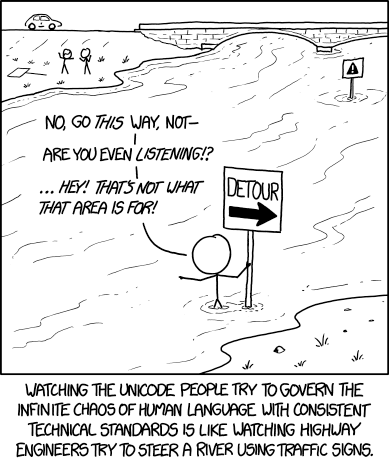Unicode

I'm excited about the proposal to add a "brontosaurus" emoji codepoint because it has the potential to bring together a half-dozen different groups of pedantic people into a single glorious internet argument.

I'm excited about the proposal to add a "brontosaurus" emoji codepoint because it has the potential to bring together a half-dozen different groups of pedantic people into a single glorious internet argument.
Cueball is a highway engineer that has been placing two traffic signs in a river trying in vain to guide the water flow and thus he ends up talking to the water trying to make it take a detour instead of going under the bridge. On the distant bank two other engineers are arguing, with gestures, in presumably a heated manner (probably about where to place a third sign, lying next to them on the bank, to make it behave a certain way)
As rivers flow according to the landscape, this plan will not work and the river will continue on its course. Cueball is very frustrated by this and is still trying to make the river obey the traffic laws. The caption lays out the punchline: The comic compares the useless approach of Cueball attempting to divert a flowing, moving river with fixed signs that do nothing, with the Unicode Consortium's attempt to define the diverse and ever-changing human language with strict technical standards.
Unicode is a largely successful attempt to have a standard for representing all possible letters, numerals, digits and symbols that make up human writing in all languages. This includes the roman letters used in this article, characters with modifiers like ê (both with the common characters as well as the modifiers selectable separately), logographic characters like in Chinese, syllabic writing system like Japanese, right-to-left and/or top-to-bottom writing systems, mathematical symbols and many other writing systems.
Emoji, one of the trendier and newer Unicode blocks, are also referenced in the title text (see below). The symbols on the signs in the river are real road signs, but interestingly enough they also both exist in Unicode, with the warning sign triangle with an exclamation mark ⚠ having code (U+26A0) and the black, rightwards arrow ➡ having code (U+27A1). As can be imagined, coping with the wide variety of character sizes, orientations, ways they can be modified, capitalization rules, etc. can get to be very challenging as the Unicode Consortium tries to write rules that accommodate how printed language is actually used. Emoji have become a recurrent theme on xkcd.
The title text refers to a proposal to add three dinosaur heads to the official list of emoji.
This is likely to stir a glorious internet argument between a half-dozen opposing (and pedantic) camps that may now be brought together, such as the following:
- Those who favor the inclusion of more emoji vs. those who oppose emoji on principle.
- Those who accept the existence of Brontosaurus vs. those who deny its status as a genus unique from Apatosaurus.
- Randall has made it clear what he believes in 636: Brontosaurus.
- Although it seems new development has occurred since the release of that comic, suggesting that Brontosaurus is a specific genus. But that is still debated...
- Those who favor a traditional, scaly image of dinosaurs vs. those who have accepted the feathered-dinosaur paradigm.
- Those who want Brontosaurus depicted as an ordinary or shrinkwrapped sauropod vs. Those who want it depicted with extra soft tissue, especially the heavy neck padding thought to be used for elephant-seal-like duels (the "Brontosmash" hypothesis).
- Those who prefer a different dinosaur species be included instead.
- Those who oppose about the possible inclusion of pterodactyls, which are not considered to be dinosaurs.
- Those who point out that two of the dinosaurs in the "Jurassic Emoji" set actually come from the Cretaceous period, and as such renaming is necessary vs. those who think that "Jurassic" is a cooler word (because of the Jurassic Park movies).
- Those who will use it as a generic emoji for dinosaurs vs. those who insist it must be used for brontosauruses only.
See also this discussion about this comic on the Unicode mailinglist...
Highway engineers were also the subject of 253: Highway Engineer Pranks and 781: Ahead Stop. Unicode was also the subject of 1953: The History of Unicode.